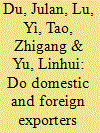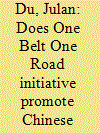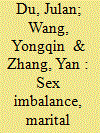| Srl | Item |
| 1 |
ID:
112721


|
|
|
|
|
| Publication |
2012.
|
| Summary/Abstract |
In view of the importance of intra-firm trade and export-platform FDI conducted by multinationals, we investigate how domestic firms and foreign affiliates exhibited differential impacts of export entry and exit on productivity changes. Using a comprehensive dataset from China's manufacturing industries, we employ the Olley-Pakes method to estimate firm-level TFP and the matching techniques to isolate the impacts of export participation on firm productivity. Robust evidence is obtained that domestic firms displayed significant productivity gains (losses) upon export entry (exit), whereas foreign affiliates showed no evident TFP changes. Moreover, the productivity gains for domestic export starters were more pronounced in high- and medium-technology industries than in low-technology ones. We explain our findings from the perspective of the technology gap theory after considering processing trade and the fragmentation of production stages in the era of globalization.
|
|
|
|
|
|
|
|
|
|
|
|
|
|
|
|
| 2 |
ID:
161776


|
|
|
|
|
| Summary/Abstract |
In response to the One Belt One Road (OBOR) initiative, China's overseas direct investment (ODI), especially whole or majority-ownership mergers and acquisitions, rose significantly in the belt-road countries, especially the ones along the continental route. Comparatively speaking, China's state-controlled acquirers played a leading role in infrastructure sectors, whereas the non-state-controlled acquirers were particularly active in non-infrastructure sectors. Central and West Asia, Western Europe and Russia are favorable destinations of Chinese ODI.
|
|
|
|
|
|
|
|
|
|
|
|
|
|
|
|
| 3 |
ID:
136280


|
|
|
|
|
| Summary/Abstract |
The Chinese government has been pursuing economic growth under the guidance of “growth is a hard principle”. Regional governments have employed the overtaking strategy (placing primary emphasis on the development of capital and technology-intensive industries) and the real estate development strategy to push for economic growth and fiscal revenue growth. This led to a primary and secondary income distribution structure biased toward capital and government and against labor and a government expenditure structure biased toward infrastructure and against social welfare. Using the empirical strategy of Acemoglu et al. (2003), we confirm that the overtaking strategy and the real estate development strategy have contributed to the internal imbalances of overinvestment and underconsumption. The biased primary and secondary income distribution structures as well as the biased government expenditure structure serve as important mediating channels through which the development strategies translate into an imbalanced consumption–investment structure. It suggests that the Chinese government will be able to accomplish China's transition from an investment-led growth model to a consumption–investment balanced growth model only if it modifies its development strategies.
|
|
|
|
|
|
|
|
|
|
|
|
|
|
|
|
| 4 |
ID:
143399


|
|
|
|
|
| Summary/Abstract |
This paper studies the effects of sex imbalance on matching patterns in China's marriage markets. We hypothesize that the economic inequality caused by economic liberalization, together with sex imbalance, will lead to women's hypergamy (marrying up). Employing CGSS data, our empirical findings support the hypothesis. We also establish that sex imbalance enhances the postnuptial bargaining power of the wife vis-à-vis the husband in intra-household resource allocation. The findings are robust to IV estimation and robustness checks.
|
|
|
|
|
|
|
|
|
|
|
|
|
|
|
|